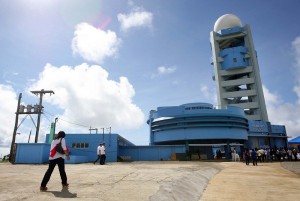Accurate forecasts seen with Doppler radar system

The new PAGASA-DOST Weather Radar Station inaugurated by Pres. Benigno S. Aquino III in Barangay Buenavista, Bato, Catanduanes. LYN RILLON
BATO, Catanduanes—President Benigno Aquino III on Wednesday inaugurated a state-of-the-art radar system here that science officials had tested and found to provide information on rainfall intensity with a 95-percent accuracy.
The P500-million Doppler radar system, one of the most advanced in the world, is the eighth radar station to be installed in the country. The radars’ integration into the current weather monitoring system will help authorities predict not only the direction of weather disturbances but also rain intensity which could provide advance warning of possible flooding.
“While the bright days ahead will occasionally be marred by showers, or even typhoons, we can assure the people that our administration is readier than ever to respond to these threats, and to help our people recover from potential damage,” the President said.
In his speech, Mr. Aquino thanked the Japanese government and the Japan International Cooperation Agency (Jica) for funding the radars—one of three it will finance. The other two radar will rise in Aparri, Cagayan, and Guiuan, Eastern Samar, next year.
He underscored the need for the authorities to be able to predict weather patterns, especially since the country lies in the path of 20 to 24 storms every year.
Article continues after this advertisement“We must continue focusing more of our resources on creating a system that will better warn us and our people about possible typhoons,” he said, noting that the Doppler radar station to be operated by the Philippine Atmospheric Geophysical and Astronomical Services Administration (Pagasa) will help the government “more accurately predict the effects of weather patterns.”
Article continues after this advertisement“This will give us more information and will help us predict more accurately the direction, the impact and the intensity of weather disturbances approaching our country. This means that we’ll be better prepared—that fewer Filipinos will be victimized by the vagaries of the weather,” he said.
Science Secretary Mario Montejo told reporters that the radar here was the “most vital and strategic installation facility” because it faces the Pacific Ocean from where 95 percent of typhoons emerge.
Aside from forecasting the direction of typhoons, weather authorities can now predict rain intensity, he said.
Montejo said they tested the radar the other day and were able to measure with 95-percent accuracy the rain that fell in Guiuan at 37 millimeters.
“You can see in real time the rains (through the radar),” Montejo said, adding that if the radar were integrated with its weather monitoring system, it can provide a six-hour warning against floods.
The President also led the ceremonial switching on of the Solong and Hitoma 1 minihydropower plants that would provide four more megawatts of electricity to the province. The plants were developed by Sunwest Water and Electricity Inc.
“We will be using the river currents that go through this island to provide power to the people of Catanduanes,” the President said.